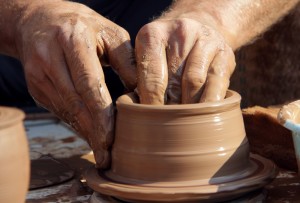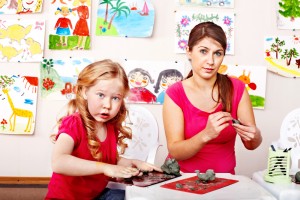
What is art if not therapy? It’s easy to understand how engaging with art might improve well-being, but that isn’t the same as tackling serious mental health problems.
We’ve heard mixed messages in relation to art therapy for schizophrenia here in the woodland (Tomlin, 2012; Judge, 2014), but what about for non-psychotic mental health disorders? After all, depression, anxiety and phobias make up the majority of mental health problems and are not associated with psychosis.
A new HTA study addresses this, considering clinical effectiveness and cost-effectiveness (Uttley, 2015). Like most HTA studies, the analysis was multifaceted. The authors hoped to identify:
- The clinical effectiveness of art therapy for people with non-psychotic mental health disorders
- User and service provider perspectives on acceptability and potential harms and benefits of art therapy
- The cost-effectiveness of art therapy for people with non-psychotic mental health disorders

This new review focused on common mental health disorders such as depression, anxiety and phobias, but excluded psychosis and schizophrenia.
What is art therapy?
Simply doing art is not art therapy. It can involve things like painting, clay work and the use of digital media as a form of nonverbal expression. Art therapy is seen as an option for people who have problems putting distress into words, or other problems with engagement. It’s important that it takes place alongside other modes of communication within a therapeutic relationship and in a therapeutic setting.
Variation in definition and delivery is surely one of the greatest challenges in the evaluation of psychological therapies. Unfortunately, like many complex interventions, art therapy lacks a clear single definition. The authors provide one for the purpose of their review, requiring that it involves:
- Definition of appropriate therapeutic boundaries
- Presence of a therapist, with an appropriate therapeutic relationship
- Therapeutic use of art materials
- Appropriateness to the cultural and service context
NICE recommends art therapy to be considered for people with psychosis and schizophrenia (NICE, 2014) and arts therapies are included in the autistic spectrum disorder Strategic Plan for Wales (Welsh Assembly Government, 2009). However, there are currently no national guidelines in the UK for the use of art therapy for non-psychotic mental disorders.

The study focused on activities such as painting, working with clay and digital media, but didn’t consider broader ‘arts therapies’ like music and dancing.
The literature search
The foundation of all 3 parts of the study is one mega literature search. 13 databases were searched along with 10 additional sources. The authors should be commended for including full details of their search terms. The searches allowed for all study types and used a flexible population definition, including mental health clinical samples (with or without formal diagnoses) as well as people with physical conditions where art therapy was used to reduce mental health symptoms. All possible comparators were considered and studies could be conducted in any setting.
The search identified 10,270 unique records. Studies conducted in people with a psychotic disorder were manually excluded through sifting, and each of the 3 stages of the study used different inclusion and exclusion criteria.
The authors describe their work as an ‘evidence portfolio’ because the research questions centre on the intervention rather than a specific population. However, the population is defined as ‘non-psychotic’ and therefore conditions like schizophrenia are excluded.

The review did not focus on a specific mental health condition or population.
Quantitative review
Non-randomised studies were excluded from the quantitative analysis, which sought to identify treatment effects associated with art therapy. Of the 10,270 records, 49 full-text articles were assessed for eligibility. 18 references were included in the analysis, which were based on 15 different studies.
Art therapy had a positive impact on mental health symptoms in 10 out of the 15 studies, but the quality of the RCTs was generally low. Study characteristics included:
- Mean sample size of 52
- 11 of 15 studies examined group art therapy
- 3 of 15 studies targeted people with non-psychotic mental disorders
- 4 of 15 studies were in cancer patients
- 4 of 15 studies were in children or adolescents
- 5 of 15 studies involved only women; 1 only men
- Number of sessions ranged from 1 to 40 (mean of 9)
These facts highlight that there was a lot of heterogeneity. Primary diagnoses included cancer, dementia/Alzheimer’s, PTSD, depression, HIV/AIDS, asthma and sickle cell disease. Comparators included treatment as usual, wait-list, attention placebo, CBT and verbal dynamic psychotherapy. Therapists were variously described as ‘trained’, ‘licensed’, ‘qualified’, ‘certified’ and ‘registered’, while some studies made no reference to accreditation. 7 studies did not describe randomisation. The majority of studies had a high risk of bias.
It wasn’t possible to perform a formal pooled analysis as there were many different outcome measures used. The table below shows the number of studies identified as beneficial or otherwise for a selection of target symptoms. We can clearly see that most studies were finding art therapy to be beneficial, but many showed no statistically significant benefit.
| Symptom / variable | Significant positive treatment effect vs control | Improvement from baseline, but no treatment effect | No improvement for art therapy | Significant negative treatment effect vs control |
| Depression | 4 | 4 | 1 | |
| Anxiety | 6 | 1 | ||
| Mood | 3 | 1 | ||
| Trauma | 3 | |||
| Distress | 2 | 1 | ||
| Quality of life | 4 | |||
| Coping | 1 | 2 | ||
| Cognition | 1 | |||
| Self-esteem | 1 |
Qualitative review
The qualitative review sought to investigate issues relating to acceptability for both patients and practitioners and how these might affect clinical effectiveness. 42 full-text articles were assessed for eligibility and 13 references (12 studies) were included in the analysis. 11 papers assessed patients’ attitudes and 2 assessed practitioner attitudes. In total the studies contained qualitative data from 188 patients and 16 health practitioners.
Benefits of art therapy identified included:
- Relationships
- Understanding
- Perspective
- Distraction
- Personal achievement
- Expression
- Relaxation
- Empowerment
Some respondents indicated that they did not think art therapy would be beneficial. In patients with cancer, a number of potential harms were identified including the potential for causing anxiety, increasing pain and leading to the activation of emotions that were not resolved.
Overall, art therapy was viewed as acceptable. In particular, a good relationship between the patient and art therapist was viewed as essential for effective treatment.

Art therapy might be harmful if a good therapeutic relationship isn’t developed.
Cost-effectiveness analysis
Essentially, the economic evaluation was a bit of a flop. The authors did their best but the data just weren’t there; 26 full-text articles were assessed but only 1 study was identified as useful. Not only that, but this was a case study of a single patient.
Nevertheless, the authors developed a simple model to evaluate cost-effectiveness in terms of cost-per-QALY, with outcomes in the primary analysis based on a single study of mindfulness-based art therapy on 111 women with cancer in the US. The analysis assumed – based on data from the British Association of Art Therapists – that treatment would be 43 sessions in a year, at a cost of £750.
This analysis suggested that art therapy, compared with wait-list control, was very likely to be cost-effective.

There were no economic evaluations of art therapy, leaving many questions unanswered.
Conclusion
The authors concluded that:
Art therapy appears to have statistically positive effects compared with controls in a number of studies in patients with different clinical profiles.
Furthermore, the report concludes that art therapy is reported to be an acceptable treatment associated with a number of benefits, and that art therapy appears to be cost-effective versus wait-list control.

The majority of research in this field is conducted by or with art therapists, who might have vested interests.
Discussion
The authors acknowledge that their approach is non-standard in that they are considering an intervention rather than a population; they essentially review art therapy being used for any health problem. This is not adequately addressed by the methodology.
My conclusions would be more circumspect than the authors’. In regard to the review of effectiveness, the authors identify various potential sources of bias. I think publication bias could be playing an important role here, but this study does not reveal much in this regard. I also do not think a claim can be made that we would expect art therapy to be cost-effective. The analysis is based on a very specific population, and outcomes are based on a mapping approach that could be unreliable. Costs might also be far from realistic; it’s worth noting that the cost-effectiveness analysis assumed that 43 sessions would be carried out over 52 weeks, yet no study identified included this many and the mean number of sessions was 9.
The authors acknowledge that “it is difficult to define or exhaustively list comparators for art therapy”. This is a key requirement of decision analysis; we cannot make the best decisions without knowing about the full range of alternatives.
Art therapy has been heavily studied, but there remains a dearth of randomised trials. Art therapists are clearly engaged with the research, but there is a need to develop better designed and more standardised randomised studies to identify whether art therapy might be worth the investment.

Ultimately, we need better quality research if we are to come to any concrete conclusions about the clinical and cost-effectiveness of art therapy for mental health disorders.
Links
Primary paper
Uttley L, Scope A, Stevenson M, Rawdin A, Taylor Buck E, Sutton A, et al. Systematic review and economic modelling of the clinical effectiveness and cost-effectiveness of art therapy among people with non-psychotic mental health disorders. Health Technol Assess 2015;19(18) [PubMed]
Other references
Judge J. Art therapy for schizophrenia: an effective add-on treatment? The Mental Elf. 27 Jun 2014.
Tomlin A. Group art therapy does no better than standard care at improving symptoms for people with schizophrenia. The Mental Elf. 5 Mar 2012.
NICE (2014) Psychosis and schizophrenia in adults: treatment and management. NICE clinical guideline, CG178, 2014. (See recommendations section 1.4.4.3: “Consider offering arts therapies to all people with psychosis or schizophrenia, particularly for the alleviation of negative symptoms. This can be started either during the acute phase or later, including in inpatient settings”).
Welsh Assembly Government (2009) The Autistic Spectrum Disorder Strategic Action Plan for Wales (PDF). A report produced by the Adult Task and Finish Group, Oct 2009.

Art therapy for common mental health disorders http://t.co/Sd5lsjuy12 #MentalHealth http://t.co/4NNB8Poz1p
@Mental_Elf Didn’t make a blind bit of difference to me I’m afraid.
Morning @Alisonscope @antheasutton @UoSCHEBS @evakaltenthaler @KimDentBrown Pls read our blog of your #ArtTherapy SR http://t.co/Zs82ElPQ27
@Mental_Elf Art therapy for common mental health disorders https://t.co/tTVhNdCW51
New post by me on art therapy. Chances are it does some people good, but we don’t really know who or if it’s worth it http://t.co/hlFGs7yfyQ
Today @ChrisSampson87 on a new HTA review & economic evaluation of art therapy for depression, anxiety & phobias http://t.co/Zs82ElPQ27
@Mental_Elf @KayFSheldon art is therapy. Nothing new. Shame the privateers well kidnap it to sell off mh wards
Hi @ScHARRSheffield @HULLPSY @ScHARRHEDS Art therapy for common mental health disorders http://t.co/Zs82ElPQ27 < Any thoughts?
@Mental_Elf Art therapy is very benefit for children with autism who struggle with verbal and social communication #psychology
Pls RT @baat_org Art therapy for common mental health disorders http://t.co/Zs82ElPQ27
Pls RT @OfficialNIHR Art therapy for common mental health disorders http://t.co/Zs82ElPQ27
Art therapy for common mental health disorders https://t.co/wDMNqxXzU1 via @sharethis
Thanks for this post. Please also see this recently published reference for a concise version of the main findings:
Don’t miss: Art therapy for common mental health disorders http://t.co/Zs82ElPQ27 #EBP
Art therapy for common mental health disorders https://t.co/wQAeVijHOI via @sharethis
#Art #therapy for common #mentalhealth #disorders via @Mental_Elf http://t.co/kJtY8INwKn
RT @arttxalliance via @Mental_Elf: Art therapy & mental health: http://t.co/gjKo9LMgAl
Art therapy for common mental health disorders via @Mental_Elf #mentalhealth http://t.co/eGr1CCWJ42
Art therapy for common #mentalhealth disorders http://t.co/TEuVVPdzpT #data #treatment #anxiety #depression http://t.co/yNZMOREb1d
#Art therapy for common #mentalhealth disorders http://t.co/J5RRvUDPOU @Mental_Elf reviews the #evidence from a #HTA study #arttherapy
Art therapy for common mental health disorders… http://t.co/pIBPwfudtS
#Art therapy for common #mentalhealth disorders http://t.co/i83I1O7T8R
Thanks for the useful information given on how art can be a therapy for mental health disorders
Saw this on Hardy Nutritional’s twitter. Very glad to see a non-biased article on dealing with mental health. Thanks! Will post links on our Natural News blog!
Interesting read, check it out http://t.co/fk7QarcjYF
http://t.co/PhIzFlYw6Y http://t.co/Ht8zPFi4mp
Art therapy for common mental health disorders:
The research journey goes on…..
#mentalhealth
@baat_org
http://t.co/lDRPhvrUBr
Growing evidence: #arttherapy effective for common mental health disorders .@MindCharity .@ArtTherapyOrg .@The_HCPC
https://t.co/Kdxlwqr5xf
Your cost analysis is wildly off. I would estimate it to be 2.5 to 4 times more expensive to provide 43 sessions in the NHS, assuming you could find an Art therapist doing 15 session per week – good luck with that. The evidence suggests art therapy is neither effective nor good value.
My name is gh kleiner, I taught myself art therapy while in a mental hospital. I want to tell others who have mental illnesses they can use drawing, cooking or gardening as tools to better mental health.
Dear Mr.Sampson, I am a high school student doing a research paper on the effectiveness of art therapy on phsycotic mental illnesses. I wanted to ask you a couple of questions if you could disclose your email I would be very thankful!
Hi Alicia. You can reach me on csampson@ohe.org. But I must admit, I’m probably not the best person to speak to about the effectiveness of art therapy. The authors of this paper could be a better starting point.
Well thank you very much for answering my comment. If you don’t mind could I bother you for their emails or at least their names, unless you can answer my question. They pretty much just consist of the availability of these therapy sessions: how much they cost, is their a payment plan, do they accept insurance. Mostly just stuff like that, but I understand if you just give me the authors email that would be find too. Thank you.
[…] are a variety of therapies for the mentally ill, and art therapy is only one of them. Ask a psychiatrist or a therapist about these and get the help you […]
I am very happy to see art therapy being taken seriously, and your article does a lot toward having it be taken seriously by people who need the stamp of approval of science. However, you contradict yourself in one small but important way. The article starts by admitting that art is in itself, therapy. Then you say that it must be done within the bounds of a therapeutic relationship (with a professional). While I agree that for most people, having a professional therapist is important and there are far more benefits to be gained from a therapeutic relationship than without, this article may discourage those without access to art therapy (it is expensive), not to try an artistic endeavour, themselves. Not everything can be quantified or explained within the scientific paradigm that has become dogmatic, and processes of the psyche and soul are one of those things. I would also agree that for someone traumatized, it can at times be “dangerous” to try to “get out” feelings artistically, without professional help. (Therefore you do make an important point). Whether it is safe, or whether it can be helpful, is determined by things within the individual psyche, unquantifiable by science and not able to be stated for all individuals, as a blanket statement in the way that statistics does.